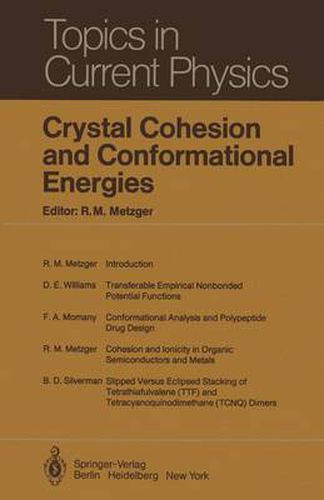Readings Newsletter
Become a Readings Member to make your shopping experience even easier.
Sign in or sign up for free!
You’re not far away from qualifying for FREE standard shipping within Australia
You’ve qualified for FREE standard shipping within Australia
The cart is loading…






This title is printed to order. This book may have been self-published. If so, we cannot guarantee the quality of the content. In the main most books will have gone through the editing process however some may not. We therefore suggest that you be aware of this before ordering this book. If in doubt check either the author or publisher’s details as we are unable to accept any returns unless they are faulty. Please contact us if you have any questions.
With the advent of X-ray diffraction and crystal structure determination in 1912 researchers in physics and chemistry began investigating the problem of crystal co hesion, i. e. , on the question of what holds crystals together. The names of M. Born, E. Madelung, P. P. Ewald, F. Bloch, E. P. Wigner, and J. E. Mayer are, in particular, associated with the pre-1940 work on the cohesion of inorganic lattices. The advent of digital computers brought along great advances in the detailed understanding of ionic crystals, molecular crystals, and metals. The work of P. O. Lowdin and r A. I. Kitaigorodosky are seminal i these more recent advances. This volume is a collection of specialist reports on a subset of the general problem of crystal cohesion. It is intended for researchers and advanced students in solid-state chemistry and physics, and biochemistry. WILLIAMS reports on the mole cule-independent empirical parameters for dispersion and repulsion that explain, and can predict, the cohesive energy of neutral organic lattices. MOMANY applies similar procedures to the conformational energy problem and shows how they can be used for the pharmacological problems of polypeptide drug design. METZGER uses quantum-mechanical molecule-dependent atom-in-molecule charges, dipole moments, and polarizabilities to study the cohesion of organic ionic (semiconducting) and par tially ionic (metallic) lattices. SILVERMAN emphasizes, with quantum-mechanical dimer calculations, the importance of dispersive interactions for the observed stacking modes in organic metallic lattices.
$9.00 standard shipping within Australia
FREE standard shipping within Australia for orders over $100.00
Express & International shipping calculated at checkout
This title is printed to order. This book may have been self-published. If so, we cannot guarantee the quality of the content. In the main most books will have gone through the editing process however some may not. We therefore suggest that you be aware of this before ordering this book. If in doubt check either the author or publisher’s details as we are unable to accept any returns unless they are faulty. Please contact us if you have any questions.
With the advent of X-ray diffraction and crystal structure determination in 1912 researchers in physics and chemistry began investigating the problem of crystal co hesion, i. e. , on the question of what holds crystals together. The names of M. Born, E. Madelung, P. P. Ewald, F. Bloch, E. P. Wigner, and J. E. Mayer are, in particular, associated with the pre-1940 work on the cohesion of inorganic lattices. The advent of digital computers brought along great advances in the detailed understanding of ionic crystals, molecular crystals, and metals. The work of P. O. Lowdin and r A. I. Kitaigorodosky are seminal i these more recent advances. This volume is a collection of specialist reports on a subset of the general problem of crystal cohesion. It is intended for researchers and advanced students in solid-state chemistry and physics, and biochemistry. WILLIAMS reports on the mole cule-independent empirical parameters for dispersion and repulsion that explain, and can predict, the cohesive energy of neutral organic lattices. MOMANY applies similar procedures to the conformational energy problem and shows how they can be used for the pharmacological problems of polypeptide drug design. METZGER uses quantum-mechanical molecule-dependent atom-in-molecule charges, dipole moments, and polarizabilities to study the cohesion of organic ionic (semiconducting) and par tially ionic (metallic) lattices. SILVERMAN emphasizes, with quantum-mechanical dimer calculations, the importance of dispersive interactions for the observed stacking modes in organic metallic lattices.